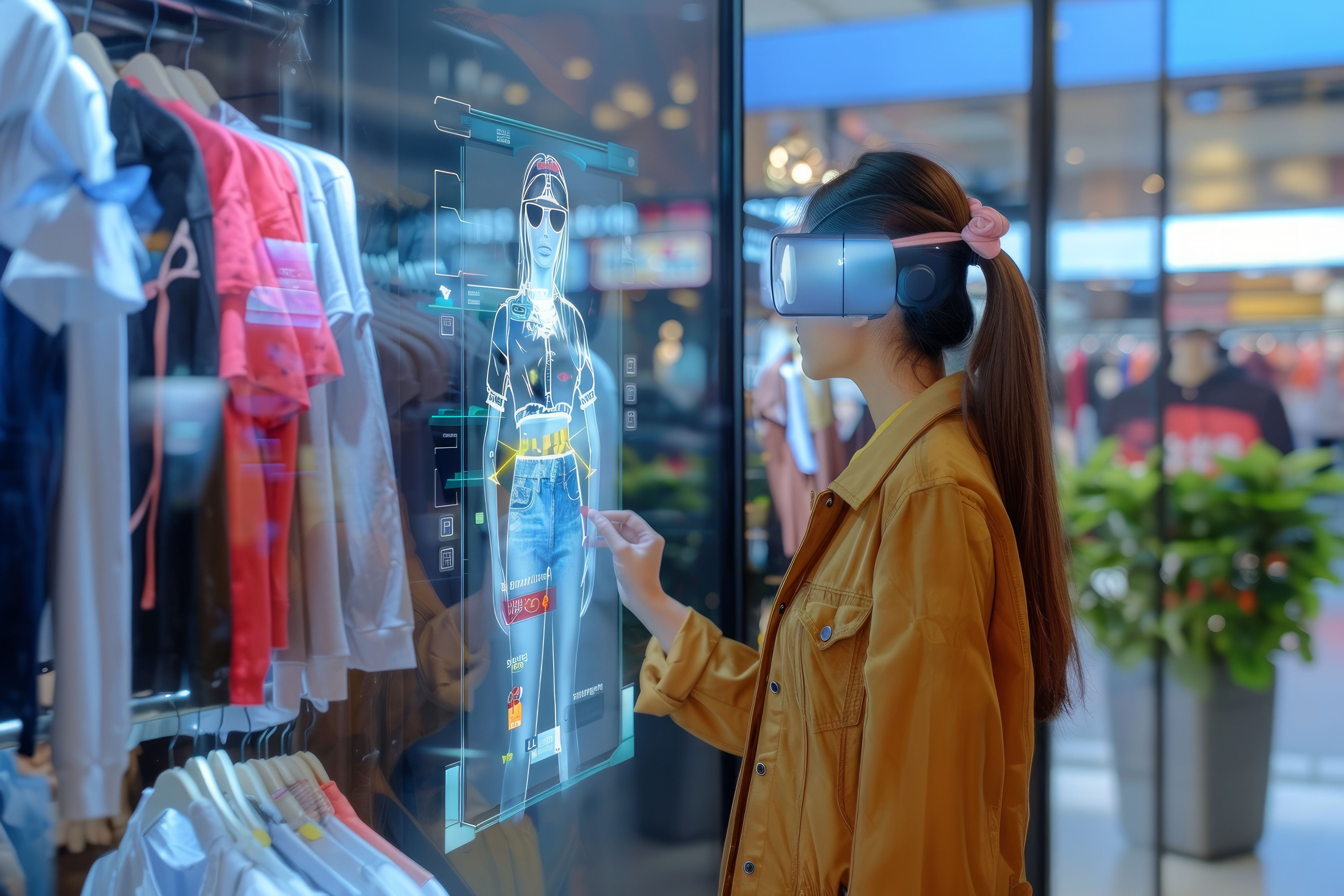How Augmented Reality Retail Shopping Is Changing Fashion?
Real AI in retail examples: From Storefronts to Smartphones


Introduction: AI Is Everywhere—You’re Probably Already Shopping with It
When you hear Artificial Intelligence in retail, you might picture futuristic robots or high-tech labs. But in reality, AI is already behind so much of how we shop every day. From the moment you scroll your smartphone lock screen and see a new outfit suggestion to that moment when a smart mirror shows you a jacket in every color without needing to try it on — these are all real AI in retail examples happening now.
In 2025, these intelligent systems are everywhere: predicting what you’ll buy next, keeping your favorite items in stock, and helping retailers cut waste and cost. They’re not just tools for brands — they’re practical, everyday AI tools for shopping that save time, personalize choices, and turn browsing into a smart experience.
In this guide, you’ll see how smart mirrors, chatbots, AR try-ons, and hidden supply chain AI are transforming shopping from storefronts to smartphones. Let’s break down the best real-world AI in retail examples — and why they matter for you.
Smart Mirrors: See AI at Work In-Store

Smart mirrors are one of the most striking AI in retail examples in physical stores today. Major brands like Uniqlo and H&M have turned the basic fitting room into an interactive experience. These mirrors use computer vision and virtual try-on tech to show you different outfits, colors, or styling tips — instantly.
Sephora’s AI Skin Scanner is another standout. Walk into a Sephora store, hold up the scanner, and AI analyzes your skin’s tone and texture to recommend the perfect foundation or lipstick. Instead of guessing shades or standing in line for a tester, shoppers get spot-on suggestions in seconds.
Even Nike is experimenting with AR-powered foot scanners to find your perfect fit and style — another practical AI tool for shopping that turns buying shoes into a custom experience.
Why it matters: These AI in retail examples show how technology saves time, boosts confidence, and reduces returns. Shoppers enjoy trying new looks without the hassle, while stores collect valuable data to serve you better next time.
AI on the Aisles: Inventory & Demand Forecasting
Behind the shelves, AI works silently to keep them full. One of the most powerful but hidden AI in retail examples is inventory and demand forecasting.
Walmart, for example, uses advanced AI to analyze millions of data points — weather, local events, buying habits — to predict exactly what shoppers will need and when. This minimizes overstocking or empty shelves.
Zara, famous for its fast fashion agility, uses AI to watch social media trends and sales patterns in real time. If a new style goes viral on TikTok, AI ensures stores restock it fast — no old stock gathering dust.
Why it matters: These AI tools for shopping aren’t just for store managers. They mean you’re more likely to find what you want in the right size, color, or fit — exactly when you want it. Plus, smarter stock levels mean fewer markdowns and less waste, helping the planet too.
Pocket AI Tools for Shopping: Smart Assistants You Carry
Not every AI in retail example lives in-store. Some live in your pocket. AI-powered shopping tools on your phone bring smart recommendations, visual search, and personalized deals right to your screen.
Glance AI, for example, curates trending fashion inspiration and shopping ideas directly on your smartphone’s lock screen. The AI learns your preferences and shows you fresh looks, seasonal ideas, or new products to match your style.
Google Lens lets you snap a photo of a pair of sneakers or a lamp you like, then finds shoppable matches across the web. No more guessing brand names — the AI does the hunting for you.
Pinterest Lens, Shopify Magic, and apps like StyleDNA or YesPlz take this further, analyzing your browsing habits, purchase history, or body profile to suggest curated outfits or products that feel handpicked.
Why it matters: These smart AI tools for shopping make it easier to discover what you love, faster. They turn any moment — a street snap, a magazine pic — into an instant shopping opportunity.
Conversational Commerce: Chatbots as Virtual Retail Staff

Another clear AI in retail example is the rise of smart chatbots. These AI assistants handle everything from sizing advice to checkout support — 24/7, no lunch breaks.
Levi’s Virtual Stylist asks you a few quick questions — size, fit, style — and then recommends the perfect pair of jeans. H&M’s chatbot helps shoppers navigate inventory, check stock availability, or pick looks by occasion.
Retailers big and small use WhatsApp, Messenger, and website chatbots powered by AI to:
- Answer product questions
- Offer style suggestions
- Upsell accessories
- Even complete purchases directly in chat
Why it matters: These chatbots don’t just save time for stores — they help you find the right product quickly, avoid endless scrolls, and feel more confident in your buy.
Visual Search & AR Try-Ons: Try Before You Buy — Virtually
Visual search and Augmented Reality are merging into must-have AI tools for shopping.
Lenskart and Warby Parker have popularized virtual eyewear try-ons. Just use your phone’s camera to see how frames fit your face shape in real time.
Amazon’s Room Decor Visualizer is a genius AI in retail example for furniture. Snap a pic of your living room, drop in a virtual couch or rug, and see how it fits before you click buy.
Snapchat’s AR Filters are another playful twist — many fashion brands now launch AR lenses so shoppers can try on shoes, jackets, or makeup within Snapchat’s app.
Why it matters: Virtual try-ons help shoppers avoid costly mistakes, reduce return rates, and make online buying feel as tactile as shopping in-store.
Personalization: The Smartest AI in Retail Example

If there’s one thing AI does best, it’s personalization. Many shoppers now expect brands to “just know” their taste — and AI delivers.
Glance AI, for instance, learns what styles you swipe on your lock screen and curates daily looks that match your mood, season, and context.
Nike’s AI tools for shopping even analyze your running style and foot shape to recommend shoes with the perfect balance of comfort and performance.
Why it matters: Personalization means no more generic ads or irrelevant suggestions. These AI in retail examples show how brands build loyalty by giving you what you really want — before you even ask.
AI for Sustainability: Smarter & Greener
Retail’s sustainability problem is real — overproduction, markdowns, and returns generate huge waste. But here, too, AI steps in.
ThredUp, a leader in resale fashion, uses AI to inspect, categorize, and price secondhand clothes automatically — making resale efficient and trustworthy.
Big brands use AI in retail examples like predictive demand planning to cut excess stock and optimize shipping routes, lowering their carbon footprints.
Why it matters: These AI tools for shopping help align what’s good for business with what’s good for the planet — a win-win for conscious shoppers.
The Future of AI in Retail Examples
So what’s next for AI in retail? Expect even smarter personalization, voice-powered shopping, and emotion-sensing systems that adapt offers to your mood in real time.
Stores might go cashier-less, with AI cameras tracking purchases as you walk out — like Amazon Go but everywhere. Smart shelves and IoT devices will monitor stock live, cutting losses and costs.
And your phone? It’ll keep evolving as your AI stylist, bargain hunter, and personal shopper — all in one.
Why it matters: The smartest retailers will mix human creativity with AI efficiency. That’s the secret to making shopping feel personal, inspiring, and effortless — for everyone.
Conclusion: Real AI in Retail Examples Are Already Changing How We Shop
From smart mirrors and virtual try-ons to pocket AI shopping tools and predictive supply chains, these AI in retail examples prove one thing: the future isn’t coming — it’s already here.
Next time you pick an outfit on your phone or chat with a bot for sizing help, you’re experiencing AI tools for shopping at work. And as they get smarter, shopping gets easier, faster, and more personal.
So whether you’re a brand or a buyer — the smartest thing you can do in 2025 is shop smart with AI.
FAQs
Q1: What are some real-world AI in retail examples?
Smart mirrors, AR try-ons, predictive inventory systems, virtual stylists, and chatbots are some clear AI in retail examples used daily.
Q2: How do AI tools for shopping make life easier?
They help you find the right product faster, personalize choices, and reduce returns — making shopping smoother.
Q3: Can small retailers use AI too?
Yes! Many AI tools for shopping are now plug-and-play — from Shopify Magic to Glance AI and visual search plugins.
Q4: Is AI only for fashion retailers?
No. Electronics, groceries, furniture — every retail category is using AI to predict demand, customize offers, or improve logistics.
Q5: Are AI chatbots really helpful?
Modern AI chatbots do much more than answer questions — they upsell, solve problems, and even complete checkouts 24/7.






